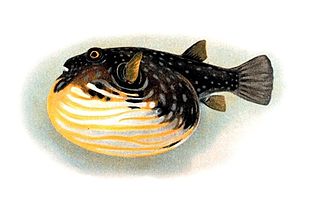
Tetraodontidae is a family of primarily marine and estuarine fish of the order Tetraodontiformes. The family includes many familiar species variously called pufferfish, puffers, balloonfish, blowfish, blowies, bubblefish, globefish, swellfish, toadfish, toadies, toadle, honey toads, sugar toads, and sea squab. They are morphologically similar to the closely related porcupinefish, which have large external spines. The scientific name refers to the four large teeth, fused into an upper and lower plate, which are used for crushing the hard shells of crustaceans and mollusks, their natural prey.
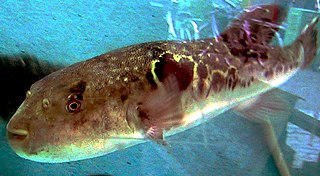
Takifugu is a genus of pufferfish, often better known by the Japanese name fugu. There are 25 species belonging to the genus Takifugu and most of these are native to salt and brackish waters of the northwest Pacific, but a few species are found in freshwater of Asia or more widely in the Indo-Pacific region. Their diet consists mostly of algae, molluscs, invertebrates and sometimes crustaceans. The fish defend themselves by inflating their bodies to several times normal size and by poisoning their predators. These defenses allow the fish to actively explore their environment without much fear of being attacked.
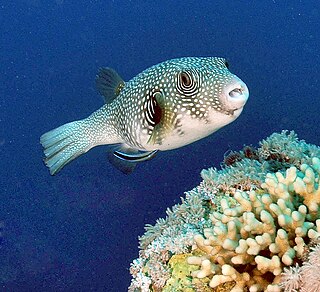
The white-spotted puffer is a medium to large-sized puffer fish, it can reach 50 cm length. It is light grey in color, or greyish or yellowish, and clearly covered with more or less regular white points, that become concentric contrasting white and dark grey lines that radiate around the eyes and pectoral fins. The ventral part is white. The "shoulder" is dark. It also has concentric contrasting white and dark grey lines that radiate around the eyes and pectoral fins.

The narrow-lined pufferfish is a demersal marine fish belonging to the family Tetraodontidae.

Lagocephalus is a genus of fish in the family Tetraodontidae (pufferfish) with a circumglobal distribution.

The oceanic puffer, Lagocephalus lagocephalus, is a pufferfish of the family Tetraodontidae, found in all tropical and subtropical oceans, at depths of between 10 and 475 m. Though indigenous to the Pacific, Atlantic and Indian oceans as well as the Sea of Japan, a surge in its distribution throughout the Mediterranean Sea has been reported in years of recent. Its length is up to 61 cm. It is thought to be responsible for fatal poisoning; therefore it should not be eaten.

The blackspotted puffer, also known as the dog-faced puffer, is a tropical marine fish belonging to the family Tetraodontidae.

The map puffer, also known as the map pufferfish, scribbled pufferfish, or Kesho-fugu, is a demersal marine fish belonging to the family Tetraodontidae. The map puffer is typically found in tropical and subtropical waters from the Indian Ocean to the western Pacific Ocean. This fish contains tetrodotoxin, a potent and deadly chemical compound used to ward off predators. Despite being highly poisonous, the map puffer can be found both in the aquarium trade and certain food markets.
Lagocephalus gloveri is a species of fish in the family Tetraodontidae. It is found in Hong Kong, Indonesia, Japan, and Taiwan.
Sicyopterus lagocephalus, the red-tailed goby or blue stream goby, is a species of goby native to islands of the Indian Ocean from the Comoros to the Mascarene Islands to the Pacific Ocean where it reaches French Polynesia and can be found as far north as Japan. It is an amphidromous species: adults can be found in swift-flowing streams with rocky beds but the eggs hatch at sea and the larval stage remains in marine waters, migrating to freshwaters when they reach the postlarval stage. This species can reach a total length of 13 cm (5 in). In some places it is an important species for local consumption with the post-larvae being caught as they mass in estuaries.

The grass puffer, or Kusa-fugu, is a species of fish in the pufferfish family (Tetraodontidae). This common to abundant species is found in the northwest Pacific Ocean in China, Japan, Korea, the Philippines and Vietnam. It is primarily found in coastal waters, ranging to depths of 20 m (66 ft), but is often seen in brackish water and has also been recorded briefly entering freshwater. The grass puffer reaches up to 15 cm (6 in) in length.
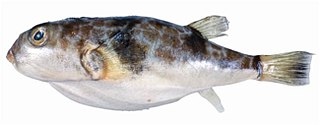
Reicheltia halsteadi, Halstead's toadfish, is a species of pufferfish endemic to Australia. This species grows to a length of 16 centimetres (6.3 in) TL. This species is the only known member of its genus.

The checkered puffer is a species in the family Tetraodontidae, or pufferfishes.

Least puffer, Sphoeroides parvus, is a species in the family Tetraodontidae, or pufferfishes. This species is the common bay and inshore puffer for the waters around Texas and Louisiana. It has also been found as far east as Apalachicola Bay and south to Yucatán. Mature least puffers are small, usually less than four inches (100 mm).

The northern puffer, Sphoeroides maculatus, is a species in the family Tetraodontidae, or pufferfishes, found along the Atlantic coast of North America. Unlike many other pufferfish species, the flesh of the northern puffer is not poisonous. They are commonly called sugar toads in the Chesapeake Bay region, where they are eaten as a delicacy, it can even be eaten raw as long as its meat is properly cleaned. In much of the Northeast, the fish is known simply as "blowfish" or "chicken of the sea".

Arothron immaculatus, the immaculate puffer or yellow-eyed puffer, is a pale greyish to brownish pufferfish from the Indo-West Pacific. It is a species of marine fish in the family Tetraodontidae.

Arothron stellatus, also known as the stellate puffer, starry puffer, starry pufferfish, or starry toadfish, is a demersal marine fish belonging to the family Tetraodontidae. It is found in shallow water in the Indo-Pacific region.
Takifugu chinensis, the Chinese puffer, is a species of fish in the family Tetraodontidae (pufferfish) that is found in coastal waters of China, Japan and Korea. This critically endangered pufferfish has drastically declined because of overfishing and habitat loss, but it is possibly also threatened by the widespread release/escape of aquacultured Takifugu rubripes within its range. These two species are similar, very closely related and perhaps should be considered conspecific, but they do differ in the colour of their anal fins.
Whitley's toadfish is a species of fish in the family Tetraodontidae that reaches a length of 9.8 cm, and is a host to Bianium plicitum.
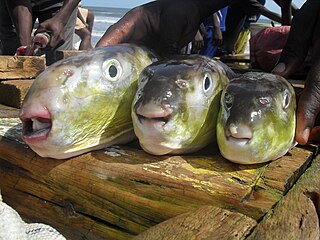
Lagocephalus laevigatus, known as the smooth puffer, is a species of pufferfish in the family Tetraodontidae. It is native to the Western Atlantic, where it ranges from New England to Argentina, as well as the Eastern Atlantic, where it ranges from Mauritania to Namibia. Adults of the species are pelagic and found near continental margins, whereas juveniles are usually found closer to shore or offshore banks, with both occurring either alone or in small, loose groups. It occurs at a depth range of 10 to 180 m over sandy or muddy bottoms and is a very large pufferfish, reaching 100 cm in total length. The species feeds on fish and shrimp and can be dangerously toxic if ingested. It is known to be oviparous. It is sometimes confused with the related species Lagocephalus inermis which is native to the Indo-Pacific.
















